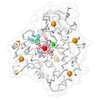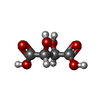[English] 日本語
 Yorodumi
Yorodumi- PDB-2z8o: Structural basis for the catalytic mechanism of phosphothreonine lyase -
+ Open data
Open data
- Basic information
Basic information
| Entry | Database: PDB / ID: 2z8o | ||||||
|---|---|---|---|---|---|---|---|
| Title | Structural basis for the catalytic mechanism of phosphothreonine lyase | ||||||
 Components Components | 27.5 kDa virulence protein | ||||||
 Keywords Keywords | LYASE / short three-helix bundle / distorted beta-strand sheet | ||||||
| Function / homology |  Function and homology information Function and homology informationLyases; Carbon-oxygen lyases; Acting on phosphates / lyase activity / extracellular region Similarity search - Function | ||||||
| Biological species |  Salmonella typhimurium (bacteria) Salmonella typhimurium (bacteria) | ||||||
| Method |  X-RAY DIFFRACTION / X-RAY DIFFRACTION /  SAD / Resolution: 2.4 Å SAD / Resolution: 2.4 Å | ||||||
 Authors Authors | Chen, L. / Wang, H. / Gu, L. / Huang, N. / Zhou, J.M. / Chai, J. | ||||||
 Citation Citation |  Journal: Nat.Struct.Mol.Biol. / Year: 2008 Journal: Nat.Struct.Mol.Biol. / Year: 2008Title: Structural basis for the catalytic mechanism of phosphothreonine lyase. Authors: Chen, L. / Wang, H. / Zhang, J. / Gu, L. / Huang, N. / Zhou, J.M. / Chai, J. | ||||||
| History |
|
- Structure visualization
Structure visualization
| Structure viewer | Molecule:  Molmil Molmil Jmol/JSmol Jmol/JSmol |
|---|
- Downloads & links
Downloads & links
- Download
Download
| PDBx/mmCIF format |  2z8o.cif.gz 2z8o.cif.gz | 100.7 KB | Display |  PDBx/mmCIF format PDBx/mmCIF format |
|---|---|---|---|---|
| PDB format |  pdb2z8o.ent.gz pdb2z8o.ent.gz | 78.2 KB | Display |  PDB format PDB format |
| PDBx/mmJSON format |  2z8o.json.gz 2z8o.json.gz | Tree view |  PDBx/mmJSON format PDBx/mmJSON format | |
| Others |  Other downloads Other downloads |
-Validation report
| Summary document |  2z8o_validation.pdf.gz 2z8o_validation.pdf.gz | 465.3 KB | Display |  wwPDB validaton report wwPDB validaton report |
|---|---|---|---|---|
| Full document |  2z8o_full_validation.pdf.gz 2z8o_full_validation.pdf.gz | 480 KB | Display | |
| Data in XML |  2z8o_validation.xml.gz 2z8o_validation.xml.gz | 23.7 KB | Display | |
| Data in CIF |  2z8o_validation.cif.gz 2z8o_validation.cif.gz | 31.4 KB | Display | |
| Arichive directory |  https://data.pdbj.org/pub/pdb/validation_reports/z8/2z8o https://data.pdbj.org/pub/pdb/validation_reports/z8/2z8o ftp://data.pdbj.org/pub/pdb/validation_reports/z8/2z8o ftp://data.pdbj.org/pub/pdb/validation_reports/z8/2z8o | HTTPS FTP |
-Related structure data
- Links
Links
- Assembly
Assembly
| Deposited unit | 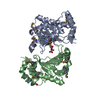
| ||||||||
|---|---|---|---|---|---|---|---|---|---|
| 1 | 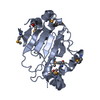
| ||||||||
| 2 | 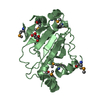
| ||||||||
| Unit cell |
|
- Components
Components
| #1: Protein | Mass: 28103.195 Da / Num. of mol.: 2 Source method: isolated from a genetically manipulated source Source: (gene. exp.)  Salmonella typhimurium (bacteria) / Gene: mkaD, spvC, vsdD / Plasmid: pGEX6p-1 / Species (production host): Escherichia coli / Production host: Salmonella typhimurium (bacteria) / Gene: mkaD, spvC, vsdD / Plasmid: pGEX6p-1 / Species (production host): Escherichia coli / Production host:  #2: Chemical | ChemComp-TLA / | #3: Water | ChemComp-HOH / | Has protein modification | Y | |
|---|
-Experimental details
-Experiment
| Experiment | Method:  X-RAY DIFFRACTION / Number of used crystals: 1 X-RAY DIFFRACTION / Number of used crystals: 1 |
|---|
- Sample preparation
Sample preparation
| Crystal | Density Matthews: 2.23 Å3/Da / Density % sol: 44.96 % |
|---|---|
| Crystal grow | Temperature: 293 K / Method: vapor diffusion, hanging drop / pH: 8 Details: 0.8M Na, K-tartrate, 100mM Tris, pH 8.0, VAPOR DIFFUSION, HANGING DROP, temperature 293K |
-Data collection
| Diffraction | Mean temperature: 100 K |
|---|---|
| Diffraction source | Source:  ROTATING ANODE / Type: RIGAKU RU300 / Wavelength: 1.5418 Å ROTATING ANODE / Type: RIGAKU RU300 / Wavelength: 1.5418 Å |
| Radiation | Monochromator: Monochromator / Protocol: SINGLE WAVELENGTH / Monochromatic (M) / Laue (L): M / Scattering type: x-ray |
| Radiation wavelength | Wavelength: 1.5418 Å / Relative weight: 1 |
| Reflection | Resolution: 2.4→99 Å / Num. all: 20794 / Num. obs: 20394 / % possible obs: 98.1 % / Observed criterion σ(F): 0 / Observed criterion σ(I): 0 / Rmerge(I) obs: 0.05 / Net I/σ(I): 63.8 |
| Reflection shell | Resolution: 2.4→2.49 Å / Redundancy: 41.2 % / Rmerge(I) obs: 0.215 / Mean I/σ(I) obs: 17.3 / % possible all: 90.9 |
- Processing
Processing
| Software |
| |||||||||||||||||||||||||
|---|---|---|---|---|---|---|---|---|---|---|---|---|---|---|---|---|---|---|---|---|---|---|---|---|---|---|
| Refinement | Method to determine structure:  SAD / Resolution: 2.4→20 Å / σ(F): 0 / σ(I): 0 / Stereochemistry target values: MAXIMUM LIKELIHOOD SAD / Resolution: 2.4→20 Å / σ(F): 0 / σ(I): 0 / Stereochemistry target values: MAXIMUM LIKELIHOOD
| |||||||||||||||||||||||||
| Displacement parameters | Biso mean: 33.3323 Å2
| |||||||||||||||||||||||||
| Refinement step | Cycle: LAST / Resolution: 2.4→20 Å
| |||||||||||||||||||||||||
| Refine LS restraints |
| |||||||||||||||||||||||||
| LS refinement shell | Resolution: 2.4→2.49 Å
|
 Movie
Movie Controller
Controller


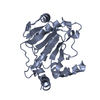
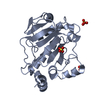




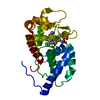
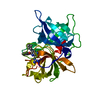
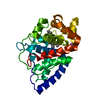
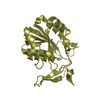
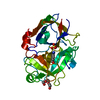
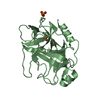
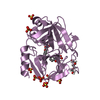
 PDBj
PDBj